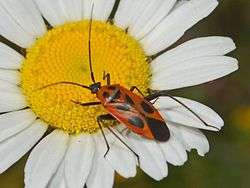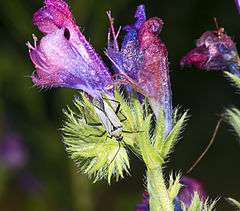Calocoris nemoralis
Calocoris nemoralis is a species of true bugs belonging to the family Miridae or jumping tree bugs, subfamily Mirinae.[2]
| Calocoris nemoralis | |
|---|---|
 | |
| Calocoris nemoralis f. hispanica, upperside | |
| Side view | |
| Scientific classification | |
| Kingdom: | |
| Phylum: | |
| Class: | |
| Order: | |
| Family: | |
| Genus: | |
| Species: | C. nemoralis |
| Binomial name | |
| Calocoris nemoralis (Fabricius, 1787) | |
| Synonyms[1] | |
|
List
| |
Forms
Forms within this species include:[3]
- Calocoris nemoralis f. bimaculata
- Calocoris nemoralis f. hexastigma
- Calocoris nemoralis f. hispanica Gmel.
- Calocoris nemoralis f. picea Cyr.
- Calocoris nemoralis f. nigrovittata Costa
- Calocoris nemoralis f. erytrocephala Mancini
- Calocoris nemoralis f. vittata
Distribution
This species can be found in most of Southern Europe (Cyprus, European Turkey, France, Germany, Greece, Italy, Malta. Portugal and Spain).[4]
Description

Calocoris nemoralis can reach a length of 8.5–9 millimetres (0.33–0.35 in) in males, of 8.2–9.5 millimetres (0.32–0.37 in) in females.[5] Bodies af these bugs are elongated. The head is black, very rarely clear. The dorsal surface is covered with dense black hairs. The membrane is black. Legs are black, femurs and tibiae are often partly red or yellow.[5]
Calocoris nemoralis is usually red coloured with black dots.[6] This species presents many forms, with an enormous variability in colors, that may be white, black, gray, yellowish, greenish or blood red, with and without black spots.[5][7]
Biology
Adults of these bugs can be found from June to September. The main host plants are Cirsium, Carduus and Silybum species. Eggs overwinter.[5]
References
| Wikispecies has information related to Calocoris nemoralis |
| Wikimedia Commons has media related to Calocoris nemoralis. |
- GBIF
- Biolib
- Natura Mediterraneo (in Italian)
- Fauna europaea
- Tifaeris Wordpress
- Kerzhner I. M.; Josifov M. (1999). "Family Miridae". In Aukema, Berend; Rieger, Christian (eds.). Catalogue of the Heteroptera of the Palaearctic Region. 3, Cimicomorpha II. Amsterdam: Netherlands Entomological Society. pp. 1–577, pages 73 &, 74. ISBN 978-90-71912-19-1.
- Animalandia (in Spanish)